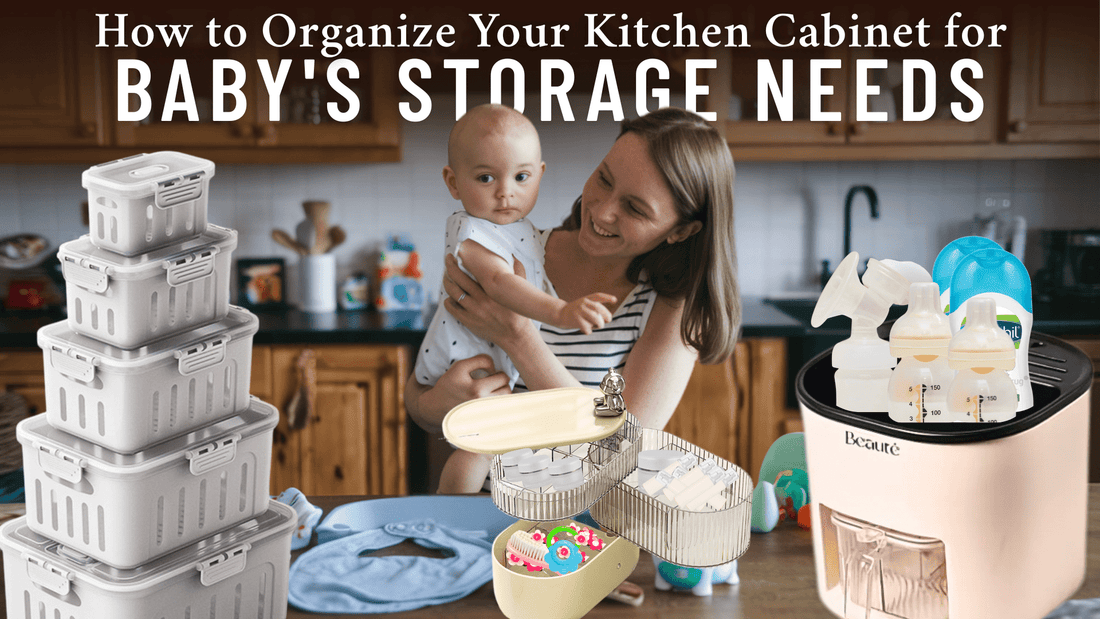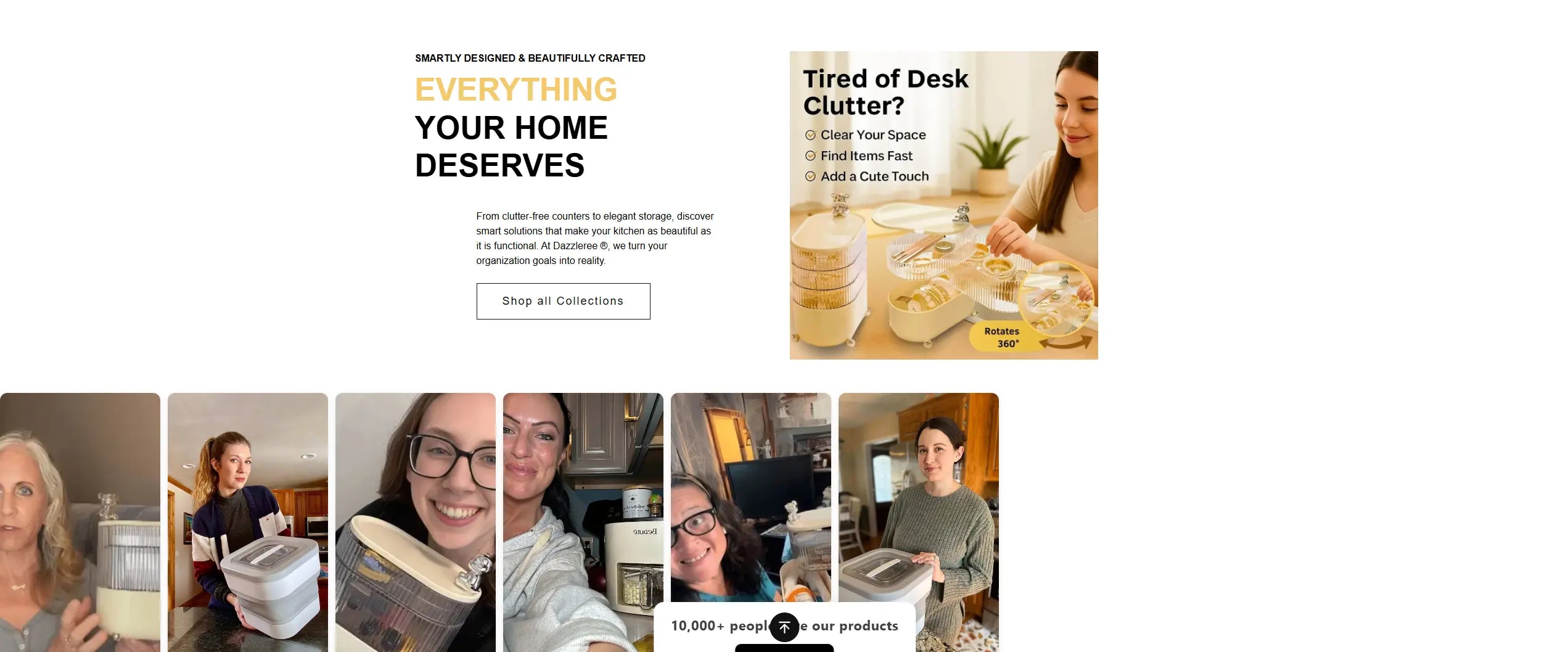
How to Organize Your Kitchen Cabinet for Baby's Storage Needs
Share
March 31, 2025
When you have a baby, your kitchen transforms into a hub for bottles, food, and tiny utensils. Finding clever ways to organize these items can save time and reduce stress during those busy feeding times. Creating dedicated cabinet spaces for baby items keeps your kitchen functional while making baby care more efficient.

Many parents struggle with kitchen clutter after a baby arrives. Using clear bins on cabinet shelves helps store backup bottles and accessories while keeping them visible. You can also repurpose existing cabinet space with dividers or small organizers to separate baby items from regular kitchen supplies.
The right organization system grows with your child. Start with bottle storage, then adapt the same space for sippy cups and eventually regular kids' dishes. Using portable storage options allows you to maintain flexibility as your baby's needs change throughout the first few years.
Key Takeaways
- Dedicated baby cabinet zones reduce daily stress by keeping essential items visible and accessible.
- Clear storage containers help everyone in the household quickly find baby feeding items when needed.
- Your organization system should be adaptable to accommodate your child's changing needs from infancy through toddlerhood.
Effective Organization Strategies

Creating an organized baby cabinet system requires thoughtful planning and practical solutions. The right approach will save you time and reduce stress during those hectic moments with your little one.
Assessing Your Space
Start by emptying your cabinets completely to understand what space you're working with. Measure the dimensions, including height, width, and depth of each shelf and drawer. This gives you an accurate picture of your storage potential.
Cabinet inventory checklist:
- Total number of cabinets/drawers
- Shelf heights and adjustability
- Door swing clearance
- Safety considerations
Consider the location of cabinets in relation to where you'll be using items. For example, feeding supplies should be near your feeding station. Diapering items work best in cabinets near the changing area.
Think about accessibility too. Items you need multiple times daily should be at eye level or within easy reach. This simple planning step creates the foundation for an efficient system.
Categorization of Baby Items
Group similar items together to create logical zones in your cabinets. This makes finding what you need much easier, especially during middle-of-the-night feedings.
Suggested categories:
- Feeding (bottles, formula, bibs, burp cloths)
- Diapering (diapers, wipes, creams, changing pads)
- Bathing (soaps, washcloths, towels, lotions)
- Health (thermometer, medicine, first aid supplies)
- Clothing (current size items, accessories)
Drawer organizers are essential for maintaining these categories. Consider using expandable drawer dividers to separate items and prevent messy drawers.
Label each zone clearly with either written labels or picture labels. This helps everyone in the household maintain the system and quickly find items when needed.
Utilizing Vertical Space
Don't limit yourself to horizontal surfaces. The vertical space in cabinets offers valuable storage potential that's often overlooked.
Install floating shelves to create additional storage levels within tall cabinets. These work perfectly for stacking diapers or organizing formula containers.
Vertical storage solutions:
- Door-mounted organizers for small items
- Stackable clear bins with lids
- Hanging organizers on cabinet doors
- Tension rods for hanging bibs or washcloths
Consider using the space under the crib for bulkier storage needs. Flat containers can slide easily underneath and store seasonal items or backup supplies.
Adding a shelving unit to the closet creates even more vertical storage options when cabinet space is limited.
Seasonal Rotation System
Babies grow quickly, making a rotation system essential for managing their changing needs without cluttering your cabinets.
Create a "current use" zone in your most accessible cabinets for items needed right now. Store upcoming sizes or seasonal items in less accessible areas or in labeled storage bins.
Quarterly rotation checklist:
- Evaluate current clothing sizes
- Swap out seasonal items (winter/summer)
- Reassess feeding supplies as baby develops
- Update first aid and medicine supplies
Keep a small notebook or digital note listing what's stored where, especially for items used infrequently. This prevents buying duplicates and helps you quickly locate items when needed.
Consider file folding clothes to maximize drawer space and visibility. This technique lets you see every item at once rather than digging through stacks.
Safety and Maintenance

Keeping your baby's cabinet organization system safe and clean requires attention to detail. Proper childproofing prevents accidents, while regular cleaning and maintenance ensure items remain hygienic and functional.
Childproofing Storage Areas
Cabinet locks are your first line of defense in kitchen safety. Install safety latches on all cabinets containing cleaning supplies, sharp objects, or small items that pose choking hazards.
Choose child-resistant containers for storing small items like bottle nipples or pacifiers. These prevent curious fingers from accessing contents while still allowing you easy access.
Consider placing dangerous items in upper cabinets. Even with locks, keep harmful substances in higher storage areas as a secondary safety measure.
Use clear bins for baby items so you can quickly identify contents without opening multiple containers. This reduces the time cabinets remain open and accessible.
Secure heavy items at the back of shelves or in lower cabinets. This prevents them from falling onto little hands that might pull at cabinet contents.
Regular Cleaning Routines
Wipe cabinet exteriors weekly with non-toxic cleaners. This prevents the buildup of food residue, fingerprints, and germs on handles and surfaces that babies touch.
Sanitize baby feeding items after each use. Bottle parts, sippy cups, and baby utensils need thorough cleaning to prevent bacteria growth.
Empty and clean storage bins monthly. Remove everything, wipe down the bins with gentle cleaners, and allow them to dry completely before refilling.
Rotate stored items seasonally to check for expired products. This is especially important for formula, baby food, and medications that may be stored in kitchen cabinets.
Quick Cleaning Checklist:
- Daily: Wipe handles and frequently touched surfaces
- Weekly: Clean cabinet exteriors
- Monthly: Deep clean storage containers
- Seasonally: Check for expired products
Maintenance Tips
Inspect cabinet hardware quarterly for loose screws or damaged parts. Tighten any loose hinges, knobs, or locks immediately to maintain safety.
Replace worn childproofing devices promptly. Even the best safety latches wear out over time, especially with frequent use.
Adjust your organization system as your baby grows. What works for infant supplies may need modification for toddler needs.
Create zones within cabinets to separate items by frequency of use. Keep daily essentials at eye level and less-used items higher up or in back corners.
Check that shelf liners remain secure and clean. These provide cushioning for glass items and prevent containers from sliding around when cabinets are opened.
Label containers clearly with contents and expiration dates when applicable. This helps all caregivers maintain the system and quickly find what they need.
Frequently Asked Questions

Baby cabinet organization combines practical storage solutions with efficient space usage. These solutions help parents maintain order in the nursery, kitchen, and throughout the home while keeping baby essentials easily accessible.
What are the best strategies for organizing baby clothes within a cabinet?
Organize baby clothes by size to prevent confusion when dressing your little one. Use drawer dividers to separate different clothing types like onesies, sleepers, and socks.
Consider sorting clothes by season, keeping current sizes at eye level for easy access. Store outgrown clothes in labeled bins at the bottom or top of the cabinet.
Fold clothes using the file folding method (standing items vertically) to see everything at once when you open a drawer. This prevents items from getting lost at the bottom of piles.
How can parents effectively utilize drawers for baby cabinet organization?
Designate specific drawers for different categories of items. The top drawer works well for frequently used items like daily outfits and diapering supplies.
Use small containers or drawer organizers to keep tiny items like socks and mittens from getting lost. Label drawers with pictures or words to help other caregivers find items quickly.
Consider a designated drawer for diaper-changing supplies including diapers, wipes, and creams. This creates a mobile changing station that can travel with you throughout the house.
Which baby cabinet designs are the most functional for a nursery?
Cabinets with adjustable shelving offer the most flexibility as your baby grows and storage needs change. Look for options with both open and closed storage components.
Rounded corners and soft-close drawers provide safety features that prevent pinched fingers. Cabinets with built-in hampers or laundry sorting sections save space and streamline your cleaning routine.
Consider cabinets with locking mechanisms for storing medications or other items that should be kept away from curious hands as your baby becomes more mobile.
What solutions are available for combining a changing table with a baby cabinet?
Using a dresser as a changing table offers excellent space efficiency. Simply secure a changing pad to the top and organize changing supplies in the upper drawers.
Specialized changing tables with built-in storage often include open shelving for easy access to diapers and wipes. Some models convert to standard dressers once your child outgrows the changing table.
Wall-mounted shelves or hanging organizers near your changing area can hold frequently used items while maximizing floor space in smaller nurseries.
How can baby feeding items be stored efficiently in the kitchen?
Create a dedicated baby feeding zone in your kitchen with all essentials within reach. Use a drawer or cabinet near your sink or food prep area for bottles, sippy cups, and feeding utensils.
Consider using cloth wipes, towels, and bibs for easy kitchen cleanup. Store these items in a dedicated drawer or basket for quick access.
Bottle drying racks and formula dispensers should have permanent spots on the counter if used daily. Otherwise, designate cabinet space specifically for these items to maintain a clutter-free kitchen.
At what age should I begin organizing my baby's cabinet and storage space?
Start organizing before your baby arrives, ideally during your second trimester. This gives you enough time to declutter existing spaces before new baby items arrive.
Consider how you'll adjust your organization system as your baby grows. Include space for larger clothes sizes and different toys and feeding supplies for various developmental stages.
Review and reorganize every 3-6 months during the first year as your baby's needs change rapidly. This regular maintenance prevents storage systems from becoming overwhelmed.
What are the essentials needed to organize kitchen cabinets for baby storage?
When organizing kitchen cabinets for your little one's necessities, you'll need storage containers, adjustable shelves, cabinet shelf dividers, and a designated area for baby bottles and kids dishes.
Modern kitchen organization systems often include stackable bins, fabric organizers, and racks that can help keep baby feeding supplies neat and easily accessible.
The key is creating a kid-friendly space that provides both utility and ease of access during hectic feeding times.
How do I choose the right baby closet organizer for kitchen storage?
When choosing a baby closet organizer for kitchen storage, look for sturdy products with adjustable features that can grow with your child's needs.
Consider fabric organizers for soft items like bibs and washcloths, and hard plastic bins for bottles and sippy cups. The perfect solution will relate to your specific kitchen design and the amount of space available.
Many modern kitchen storage systems include specialized compartments that can be adapted for baby items while maintaining a cohesive look with your overall kitchen inspiration.
How can I create space for baby items in a small kitchen pantry?
To create space for baby in a small kitchen pantry, utilize vertical storage with adjustable shelves and stackable containers.
Designate a specific shelf or cabinet exclusively for baby necessities. Use clear bins to organize similar items like baby food, snacks, and kids cups. Installing a utility rack on the inside of pantry doors can provide additional storage for small items.
Remember that smart pantry ideas often focus on maximizing every inch of available space while keeping items visible and accessible.
What's the best way to organize baby bottles and feeding accessories in kitchen cabinets?
The best way to organize baby bottles and feeding accessories is to designate a specific cabinet shelf near your sink for ease of washing and preparation. Use sturdy dividers to separate bottles, nipples, and other small parts.
Consider a specialized drying rack that fits neatly on your countertop or inside cabinets. Many parents find that cute, labeled storage containers help maintain organization while adding a pleasant aesthetic to your kitchen storage system.
For additional convenience, keep related items grouped together, like formula with bottles or baby food with spoons.
How can I make my kitchen cabinet organization system grow with my kid?
To create a kitchen organization system that grows with your kid, invest in adjustable storage solutions with movable shelves and expandable dividers.
Begin with space for baby bottles and purees, then gradually transition to storage for sippy cups, kids dishes, and eventually school lunch supplies. Fabric bins work well as they can be repurposed for different items as your child grows.
Look for modern systems that include various bin sizes that can be reconfigured as needs change, providing long-term utility for your kitchen storage needs.
What double-duty kitchen cabinet organizers work well for both baby items and regular kitchen storage?
Double-duty cabinet organizers that excel for both baby and regular kitchen storage include tiered shelf organizers, pull-out drawer systems, and adjustable dividers. Clear storage containers can hold baby food jars now and spices later.
Turntables (lazy Susans) work wonderfully for baby food storage and can later be used for condiments or baking supplies.
Many modern kitchen ideas incorporate these versatile storage solutions that seamlessly integrate baby necessities while maintaining the overall kitchen design aesthetic.
How do I organize a cabinet for baby food and snacks in the pantry?
To organize a cabinet for baby food and snacks in the pantry, start by installing adjustable shelves to accommodate different sized items. Use sturdy, clear bins to categorize foods by type or age appropriateness.
Consider adding shelf liners to prevent jars from sliding. Utilize cabinet door space for thin items like pouches using an over-the-door rack.
Label everything clearly for easy identification, which is especially helpful when others may help with feeding your little one. Many modern pantry ideas include specialized baby food organizers that keep everything visible and maintain neat, accessible storage.
What are some creative ways to store diaper changing supplies in kitchen cabinets?
Creative ways to store diaper changing supplies in kitchen cabinets include using fabric bins with handles for easy transport around the house, utilizing rotating desk organizers for organizing smaller items like creams and ointments, and installing a pull-out cabinet shelf to create an accessible changing station.
Some parents explore multi-level organizers that keep diapers on the bottom and wipes on top for easy access.
A cute basket or bin specifically designated for diaper accessories can be stored on a lower shelf when not in use, keeping your kitchen cabinets organized while providing convenience for quick changes.
How can I help maintain organization in baby's kitchen storage areas?
To help maintain organization in baby's kitchen storage areas, establish a regular cleaning and restocking routine. Use clear, labeled bins so everyone in the household knows where items belong.
Consider implementing the "one in, one out" rule for baby items to prevent overcrowding. Review and adjust your storage system every few months as your baby's needs change.
Related posts and neat method-kitchens techniques often suggest creating designated zones for different categories of baby items, making it easier to discover what you need quickly and maintain the organizational systems you've established.


